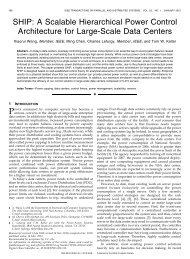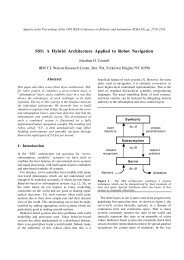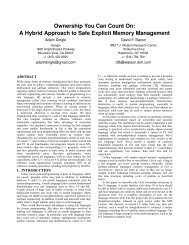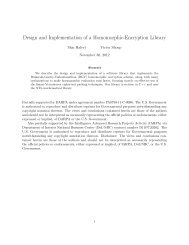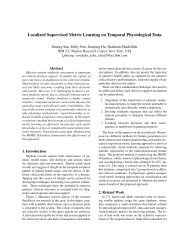2. If all vectors of a θ-orthogonal (θ > π √3 ) basis have lengths less than 3sinθ+ √ times the length3cos θof the shortest basis vector, then the basis is the unique π 3-orthogonal basis for the lattice (up tomultiplication of basis vectors by ±1).Gauss [13] proved the first property for 2-D lattices. We prove (generalizations of) the above properties form-D lattices for arbitrary m.We also study lattices generated by a set of r<strong>and</strong>om vectors; we focus on vectors comprising Gaussianor Bernoulli (± √ 1n) entries. The set of vectors <strong>and</strong> the generated lattice are henceforth referred to as ar<strong>and</strong>om basis <strong>and</strong> a r<strong>and</strong>om lattice, respectively. R<strong>and</strong>om bases <strong>and</strong> lattices find applications in coding [7]<strong>and</strong> cryptography [28]. We prove an appealing property of r<strong>and</strong>om lattices.If a r<strong>and</strong>om lattice L in R n is generated by m ≤ cn (c ≈ 0.071) r<strong>and</strong>om vectors, then the r<strong>and</strong>omvectors form a π 3-orthogonal basis of L with high probability at finite n <strong>and</strong> almost surely as n → ∞.Consequently, the shortest vector in L is contained by the r<strong>and</strong>om basis with high probability.We exploit properties of nearly orthogonal bases to solve an interesting digital image processing problem.Digital color images are routinely subjected to compression schemes such as the Joint PhotographicExperts Group (JPEG) st<strong>and</strong>ard [26]. The various settings used during JPEG compression of an image—termed as the image’s JPEG compression history—are often discarded after decompression. For recompressionof images which were earlier in JPEG-compressed form, it is useful to estimate the discardedcompression history from their current representation. We call this problem JPEG compression history estimation(JPEG CHEst). The JPEG compression step maps a color image into a set of points contained in acollection of related lattices [23]. We show that the JPEG CHEst problem can be solved by estimating thenearly orthogonal bases spanning these lattices. Then, we invoke the derived properties of nearly orthogonalbases in a heuristic to solve the JPEG CHEst problem [23].<strong>Lattice</strong>s that contain nearly orthogonal bases are somewhat special 1 because there exist lattices withoutany π 3-orthogonal basis (see (4) for an example). Consequently, the new properties of nearly orthogonallattice bases in this paper cannot be exploited in all lattice problems.The paper is organized as follows. Section 2 provides some basic definitions <strong>and</strong> well-known resultsabout lattices. Section 3 formally states our results on nearly orthogonal lattice bases <strong>and</strong> Section 4 furnishesthe proofs for the results in Section 3. Section 5 identifies new properties of r<strong>and</strong>om lattices. Section 6 describesthe role of nearly orthogonal bases in the solution to the JPEG CHEst problem. Section 7 concludeswith a discussion of some limitations of our results <strong>and</strong> future research directions.2 <strong>Lattice</strong>sConsider an m-D lattice L in R n , m ≤ n. By an ordered basis for L, we mean a basis with a certainordering of the basis vectors. We represent an ordered basis by an ordered set, <strong>and</strong> also by a matrix whosecolumns define the basis vectors <strong>and</strong> their ordering. We use the braces (.,.) for ordered sets (for example,(b 1 ,b 2 ,...,b m )), <strong>and</strong> {.,.} otherwise (for example, {b 1 ,b 2 ,... ,b m }). For vectors u,v ∈ R n , we use bothu T v (with T denoting matrix or vector transpose) <strong>and</strong> 〈u,v〉 to denote the inner product of u <strong>and</strong> v. Wedenote the Euclidean norm of a vector v in R n by ‖v‖.Any two bases B 1 <strong>and</strong> B 2 of L are related (when treated as n × m matrices) as B 1 = B 2 U, where U is am × m unimodular matrix; that is, an integer matrix with determinant equal to ±1.1 However, our r<strong>and</strong>om basis results suggest nearly orthogonal bases occur frequently in low-dimensional lattices.2
The closest vector problem (CVP) <strong>and</strong> the shortest vector problem (SVP) are two closely related, fundamentallattice problems [1, 2, 10, 15]. Given a lattice L <strong>and</strong> an input vector (not necessarily in L), CVP aimsto find a vector in L that is closest (in the Euclidean sense) to the input vector. Even finding approximateCVP solutions is known to be NP-hard [10]. The SVP seeks a vector in L with the shortest (in the Euclideansense) non-zero length λ(L). The decision version of SVP is not known to be NP-complete in the traditionalsense, but SVP is NP-hard under r<strong>and</strong>omized reductions [2]. In fact, even finding approximately shortestvectors (to within any constant factor is NP-hard under r<strong>and</strong>omized reductions [16, 20].A shortest lattice vector is always contained by orthogonal bases. Hence, one approach to finding shortvectors in lattices is to obtain a basis that is close (in some sense) to orthogonal, <strong>and</strong> use the shortestvector in such a basis as an approximate solution to the SVP. A commonly used measure to quantify the“orthogonality” of a lattice basis {b 1 ,b 2 ,... ,b m } is its orthogonality defect [17],∏ mi=1 ‖b i‖|det([b 1 ,b 2 ,... ,b m ]) | ,with det denoting determinant. For rational lattices (lattices comprising rational vectors), the Lovász basisreduction algorithm [17], often called the LLL algorithm, obtains an LLL-reduced lattice basis in polynomialtime. Such a basis has a small orthogonality defect. There exist other notions of reduced bases due toMinkowski, <strong>and</strong> Korkin <strong>and</strong> Zolotarev (KZ) [15]. Both Minkowski-reduced <strong>and</strong> KZ-reduced bases containthe shortest lattice vector, but it is NP-hard to obtain such bases.We choose to quantify a basis’s closeness to orthogonality in terms of the following new measures.• Weak θ-orthogonality: An ordered set of vectors (b 1 ,b 2 ,... ,b m ) is weakly θ-orthogonal if for i =2,3,...[ ],m, the angle between b i <strong>and</strong> the subspace spanned by {b 1 ,b 2 ,...,b i−1 } lies in the rangeθ,π2 . That is,⎛cos −1 ⎝ |〈b i, ∑ ⎞i−1j=1 α i b i 〉|‖b i ‖ ∥ ∑ ⎠i−1j=1 α ≥ θ, for all α j ∈ R with ∑ |α j | > 0. (1)i b i 〉 ∥j• θ-orthogonality: A set of vectors {b 1 ,b 2 ,... ,b m } is θ-orthogonal if every ordering of the vectorsyields a weakly θ-orthogonal set.A (weakly) θ-orthogonal basis is one whose vectors are ((weakly) √2 ) θ-orthogonal. Babai [4] proved that ann;n-D LLL-reduced basis is θ-orthogonal where sin θ = for large n this value of θ is very small.Thus the notion of an LLL-reduced basis is quite different from that of a weakly π 3-orthogonal basis.We will encounter θ-orthogonal bases in r<strong>and</strong>om lattices in Section 5 <strong>and</strong> weakly θ-orthogonal bases(with θ ≥ π 3) in the JPEG CHEst application in Section 6.3 <strong>Nearly</strong> <strong>Orthogonal</strong> <strong>Bases</strong>: ResultsThis section formally states the two properties of nearly orthogonal lattice bases that were identified in theIntroduction. We also identify an additional property characterizing unimodular matrices that relate twonearly orthogonal bases; this property is particularly useful for the JPEG CHEst application.Obviously, in an orthogonal lattice basis, the shortest basis vector is a shortest lattice vector. Moregenerally, given a lattice basis {b 1 ,b 2 ,...,b m }, let θ i be the angle between b i <strong>and</strong> the subspace spanned by33









